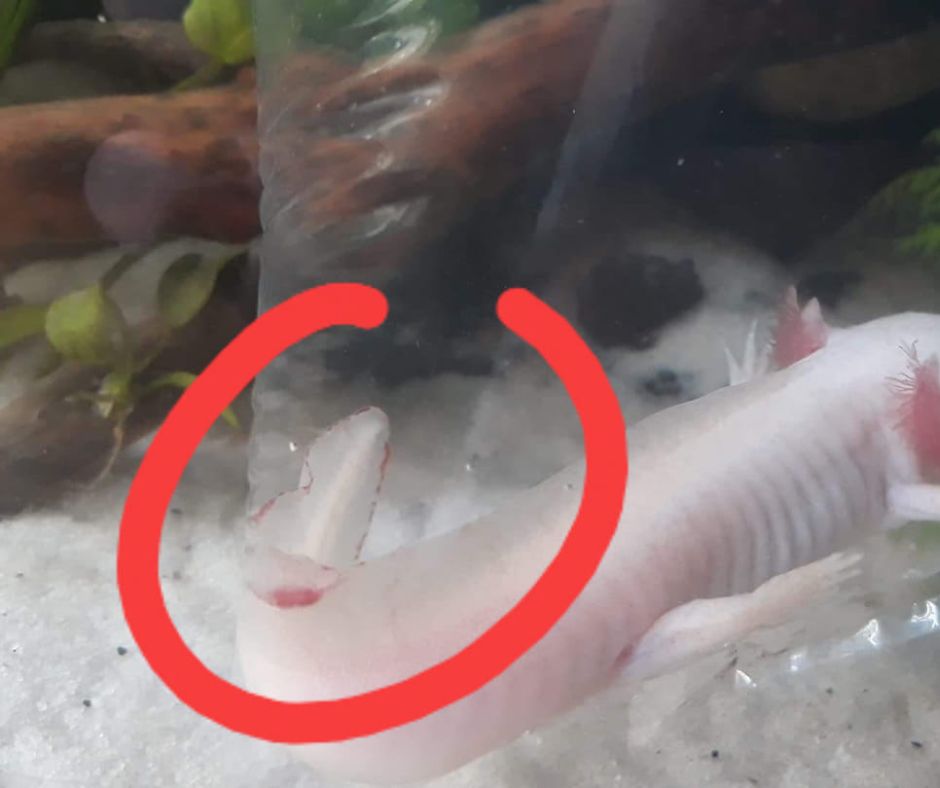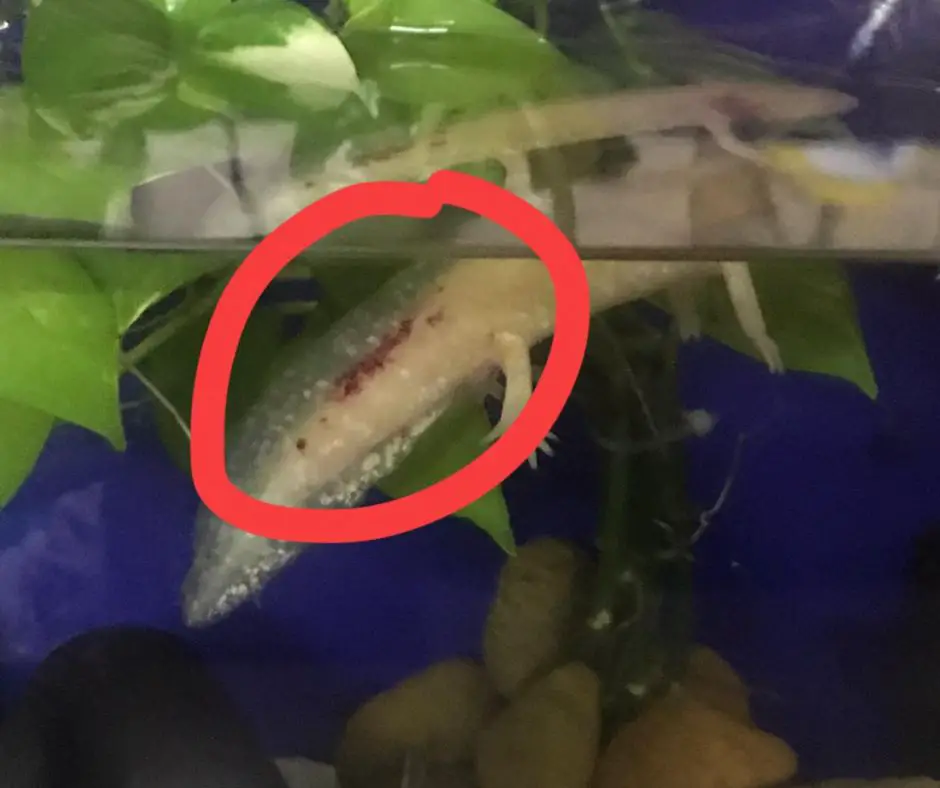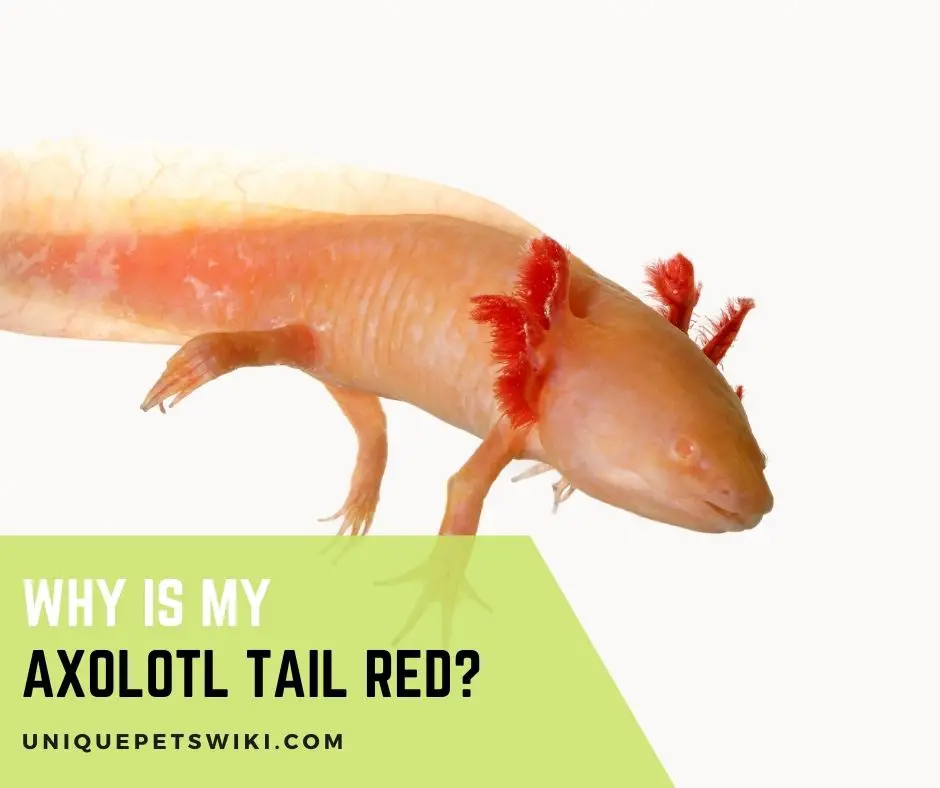Axolotls are health-conscious pets who are prone to a variety of physical ailments.
Localized infections and skin lesions can be caused by parasites and fungus. Curled tails, red tails, and deteriorated tails are also common in axolotls. So, Why Is My Axolotl Tail Red?
There is no one reason for an axolotl’s gills, skin, or tail to turn red. People should be aware of the circumstances that cause axolotl tails to turn red.
Bacterial infections, ammonia burns, and skin inflammations can all cause redness.
The causes that cause the axolotl tail to turn red will be discussed in this article. The article will also include information on how to cure and avoid tail redness.
So, read the entire article to learn about the additional issues with axolotl tails.
Contents
Why Is My Axolotl Tail Red?
The presence of blood vessels in the tail causes the axolotl’s red tail. You may detect red gills and tail soon after swimming, which is due to increased blood flow.
Furthermore, the tail of an axolotl with less pigment appears red.
A bacterial infection is the cause of the red spots on the underside of the tail. The axolotl tries to scratch the red spots.
Stress is caused by poor water quality, and the axolotl tail turns red as a result. Examine the symptoms; if the tail is bright red with no scratches or red spots, there is no reason to be worried.

Blood Circulation Is Raised
The red color of blood is due to the presence of hemoglobin in the axolotl’s blood. The increased blood flow to the tail leads it to turn red, which is not a problem.
When axolotls are swimming, moving, and active, they turn red.
Axolotls turn red during the breeding season due to hormonal imbalance, which causes an increase in blood pressure. If axolotls are unable to find a mate, this might cause stress.
So, keep an eye out for warning signals and take efforts to maintain your axolotl in good condition.
Bacterial Infection: Red Leg
Aeromonas hydrophila causes axolotls to develop a red leg infection on their skin. It is distinguished by red patches, scratches, and skin inflammation.
The irritation causes axolotls to scratch the red spots. As a result, red patches and scratches may appear all over the skin.
The illness causes a loss of appetite, lethargy, and epidermal itching. The infection is caused by low water quality and unsanitary tank conditions.
To minimize bacterial development, you can use 100% Holtfreter’s solution. You can also visit a veterinarian to get the antibiotic dosage.
Check out: Axolotl Red Leg: Causes and Treatment
Ammonia Burn
Skin burns and axolotl redness are caused by ammonia in the tank. The ammonia level must be kept below zero, or the axolotl would die in a matter of days.
Skin redness, gasping for oxygen, loss of appetite, floating, and gills falling are all signs of excessive ammonia levels in the tank.
You must remove the axolotl from the aquarium and thoroughly clean it. To reduce ammonia burn, give an axolotl a tea bath with Cattappa leaves.
Replace the water on a regular basis and keep the temperature between 60- and 64-degrees Fahrenheit.
Check out: How to Keep An Axolotl Tank Clean
Stress
Axolotl tails turn red or curled when they are stressed. Poor water quality and an unhealthy diet both cause stress.
As a result, the axolotl is subject to a variety of health problems. So, maintaining good water quality and a sanitary environment in the tank is critical.
Also read: Full Requirements & Water Conditions for Axolotl in Captivity
What Should You Do If Axolotl Tail Red?
You should inspect the tank’s water quality and ammonia levels. Change the water if you notice any changes. After that, check the tail redness.
Use a tea bath to prevent bacterial growth if you observe red spots and patches on the underside of the tail.
In the meantime, improve the water quality; if the axolotl’s condition does not improve, consult a veterinarian. The veterinarian will either prescribe antibiotics or suggest a solution to add to the water.
Axolotl Tail and Its Related Problems

- Axolotl tail floating up
Impaction, excessive ammonia levels, or stress cause the axolotl tail to float up. When an axolotl eats something hard, such as gravel, it might obstruct its digestive tract.
The axolotl floats as a result of this. This is a life-threatening condition.
Check out: Axolotl Tail Floating Up: Basic Cause And Treatment
- Axolotl curled tail
The curled tail of an axolotl is a visible indicator of stress. Stress can be caused by poor water quality, high ammonia levels, high nitrate levels, and temperatures that are too hot or too cold.
It is critical to maintaining the water clean and the axolotls stress-free.
Check out: Why Are My Axolotls’ Tails Curled?
- Axolotl fin rot
Injury, as well as fungal and bacterial diseases, cause axolotl fin rot. Axolotls can regenerate their organs, but infection and rotting can slow down the process.
Check out: Axolotl Fin Rot: Cause, Treatment, and Prevention
Marineland Penguin Bio-Wheel Power Filter
- WITH ROTATING BIO-WHEEL: Patented Bio-Wheel technology provides excellent wet/dry biological filtration
- MULTI-STAGE FILTRATION: Delivers mechanical, chemical and biological aquarium filtration to maintain a clean aquatic environment
- MARINELAND FILTRATION PRODUCTS: Count on Marineland brand for the most reliable, technically advanced aquariums and accessories on the market
- COMPATIBILITY: Use with Marineland Rite-Size Filter Cartridges (see individual filter for sizing recommendations)
- FIVE SIZES: Available in 75 GPH, 100 GPH, 150 GPH, 200 GPH and 350 GPH sizes
Last update on 2022-12-30 / Affiliate links / Images from Amazon Product Advertising API
FAQ
How can I tell if my axolotl is stressed?
You can tell by looking for stress signs and symptoms. Lethargy, loss of appetite, curled tail tip, skin discoloration, floating, and gulping air are all signs of stress in axolotls.
What does it mean when axolotls change color?
When axolotls are active, their gills and skin change color due to increased blood flow. Axolotls, on the other hand, lose pigmentation while resting and their color changes depending on the color of their surroundings.
Why is my axolotl turning pink?
The reddish color of an axolotl can indicate health problems or stress. As a result, you must inspect the water quality, temperature, and parameters.
How to treat red legs in axolotl?
Tea baths can be used to treat axolotl red leg because they prevent bacteria from growing in the tank. A veterinarian can also prescribe antibiotics to treat the red leg.
Why is my axolotl’s tail wavy?
It’s because of the tank’s stress and poor water quality. You should inspect the tank’s water parameters and nitrogen cycle. Axolotls may have health problems even if the water quality and parameters are adequate.
How to treat a sick axolotl?
It depends on the sickness of the axolotl. Antibiotics can be given to an axolotl with a bacterial infection. Antifungal drugs can be used if it has a fungal infection. However, whenever you feel your axolotl is sick, improve the water quality.
Final Sentences
Increased blood flow, bacterial infection, ammonia burn, or stress cause the axolotl tail to turn red. Check the water parameters as well as the severity of the redness.
After that, improve the water quality and keep the tank clean. If the axolotl’s condition does not improve, consult a veterinarian.

